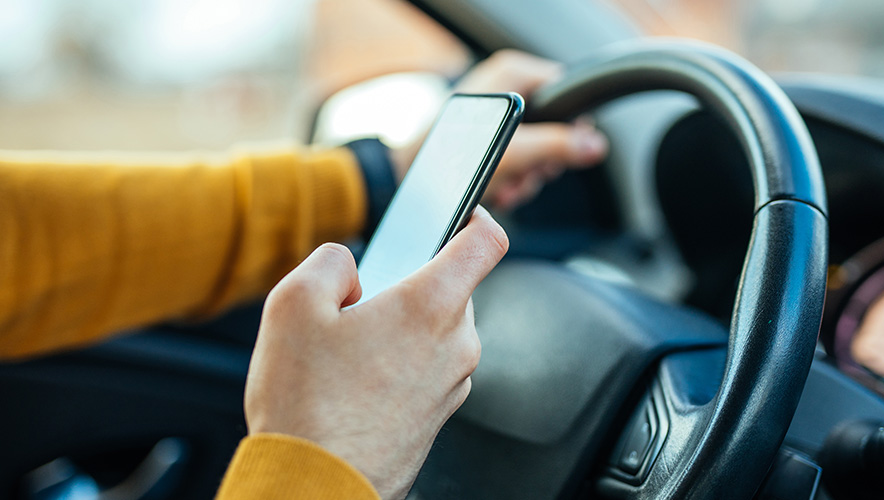Do Device-Free Driving Laws Reduce Crashes?
Cell phones were distracting enough before they became multiuse devices that serve as a GPS, camera, search engine, and more. When the user is behind the wheel of a car, those distractions can become deadly. In response to distracted driving traffic crashes, some U.S. states implemented bans on using or holding cell phones while driving, but are they effective?
Research released 9 August by the Insurance Institute for Highway Safety (IIHS) reviewed data from Oregon, Washington, and California—three U.S. states with broad prohibitions on cell phone use in cars—and compared it to Colorado and Idaho, which just prohibit texting while driving, the Associated Press reported.
Oregon and Washington have the strictest rules out of this set—both made it illegal to hold a cell phone or other electronic device while behind the wheel of a car, including when the vehicle is stopped in traffic or at a red light. California prohibits “holding and using” a cell phone—which does not necessarily apply to picking up a phone from the passenger seat and plugging it in or clipping it into a smartphone mount. California’s laws also do not specifically apply to temporary vehicle stops.
“In general, states have taken two approaches to deal with the expanded potential for distracted driving, either attempting to enumerate all the forbidden operations or drafting broad prohibitions against holding or using a phone or similar electronic device while in the driver seat on a public road,” according to IIHS. Because technology evolves so quickly and drivers may have different interpretations on what counts as interacting with a device while driving (does tapping on your phone to accept a faster route on Google Maps count?), the broader the application the better, researchers said.
IIHS researchers examined crash rates in three states that adopted broad bans on holding or using a phone or similar electronic device while in the driver's seat. Two of those states saw crashes go down substantially.
— IIHS (@IIHS_autosafety) August 9, 2022
Learn more: https://t.co/ii0gGrw1d6 pic.twitter.com/wDsKKBpNQm
Researchers at the IIHS examined crash rates—specifically police-reported rear-end crashes. “Rear-end crashes were chosen because past research has shown that cell phone use is associated with a much larger increase in the odds of those crashes than any other type,” the Institute said.
After Oregon and Washington adopted laws against holding a phone while driving, their monthly rate of rear-end crashes with injuries per 100,000 people dropped significantly—11 percent in Washington and 9 percent in Oregon. California, with its more interpretive law, did not see the same significant effect.
“The greater clarity of the Oregon and Washington laws, especially with regard to temporary stops, may partly explain their greater success,” the researchers found. “Using plain, straightforward language to ban all hand-held cell phone use while driving, including simply holding a phone, may not only boost driver compliance but also make police more willing to issue tickets by making infractions easier to identify and less likely to be dismissed in court. The presumption is that increased enforcement also results in greater compliance.”
The varying fine amounts and penalties across these three states’ laws may also influence their effect on crash rates, IIHS said. In the more successful states, penalties are more severe: base fines for the first and second offense were $136 and $234 in Washington and $265 and $440 in Oregon. In California, the base fines were just $20 and $50. In Oregon, a third offense can lead to a $2,000 fine, a criminal misdemeanor charge, and six months in jail.
Motor vehicle crashes are the leading cause of death in the United States, according to the U.S. Centers for Disease Control and Prevention (CDC). Nearly 43,000 people die in preventable crashes every year in the United States. The United States had the fourth highest vehicle-based death rate in 2019—1.21 per 10,000 registered vehicles—and the rate is 1.65 times higher than the average for 27 other high-income countries, the National Safety Council reported.
The U.S. National Transportation Safety Board (NTSB) has listed eliminating distracted driving as one of its most wanted transportation safety improvements for 2021-2022.
#DYK: Extra passengers, making a phone call, sending a text, or any activity that takes your eyes & mind off the road is a dangerous decision. Put distractions to the side until you park your ride. #NTSBmwl #100deadliestdays #distracteddriving pic.twitter.com/RZr4YcXib4
— NTSB (@NTSB) July 29, 2022
“Distracted driving is widespread, killing thousands and injuring hundreds of thousands in the United States every year,” the NTSB explained. “States are making some progress addressing this public health problem, but no state has implemented our recommendation calling for a ban on the use of all personal electronic devices while driving except in case of emergency. Today, 24 states and the District of Columbia prohibit drivers of all ages from using handheld cell phones while driving. Forty-eight states and DC have an all-driver text messaging restriction. However, Missouri and Montana have yet to adopt an all-driver text messaging ban, and drivers in Nebraska and Ohio are only subject to secondary enforcement. Thirty-seven states and DC restrict the use of cell phones by novice drivers.”
Distracted driving is not the only significant risk at play, though. The CDC noted in its report that inconsistent safety restraint use and speeding remain persistent issues. Around 47 percent of U.S. passenger vehicle occupants who were killed in car crashes in 2019 were unrestrained. In addition, reducing speeds could save lives. Speeding contributes to approximately 27 percent of U.S. motor vehicle crash deaths.
